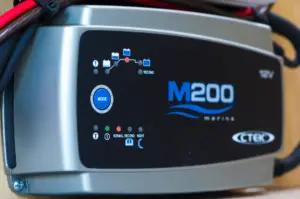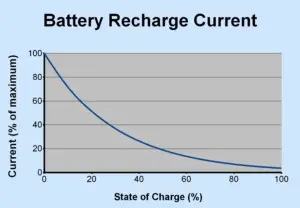CHARGING TIMES
Why does it take so long to recharge a lead acid battery?
WORDS AND DIAGRAMS BY JOSEPH WOERKOM, PHOTOGRAPHY BY CARAVAN AND MOTORHOME

How long does it take to fully charge a 100Ah lead acid battery that is 50% discharged with a 10A battery charger? The simple answer would be to divide the amount of charge lost (50% of 100Ah or 50Ah) by the available current (10A) to arrive at a time of five hours.
Unfortunately you might be disappointed to hear that it will take a lot more than the calculated time. The reason is because the amount of current that a lead acid battery will accept drops as its State of Charge (SOC) increases.
One way of looking at this is to imagine the battery as a tall water tank that is being filled from the bottom by some kind of pump. It’s easy to see that as the water level in the tank rises, the pressure required to pump more water into it also rises. If the pump can’t generate sufficient pressure the rate at which water flows into the tank falls.
This means that the closer the tank gets to being filled the more time it takes to get another litre of water into it. If we want to keep the water flow into the tank at a constant rate we would have to keep increasing the pump’s pressure to compensate for the rise in pressure inside the tank.
This is essentially what a multi-stage battery charger does during bulk charging. It keeps raising its output voltage to maintain a constant current going into the battery until the battery voltage rises to the maximum level which is safe for the chosen battery chemistry (wet cell, GEL or AGM). However, at this point the battery is not fully charged and is at best around 80% SOC.
To get the next 20% of charge into the battery, the charger then switches to absorption mode. In this mode, the charger holds its output voltage constant and the amount of current going into the battery continuously falls as the battery becomes more charged.
Eventually, when the current falls below a predetermined value, the charger assumes that the battery is now fully charged and switches to float mode. In this mode the charger reduces its voltage to a level just above the fully charged battery voltage to maintain the battery at 100% SOC.
To reduce the overall charging time, use a battery charger with a higher amperage rating. However, this will only reduce the time spent in the bulk stage of the charging process, not the absorption stage.
Also, be warned that some batteries have a limit on the maximum recharge current allowed and may be damaged if the charger’s rated output current is too high. Deep cycle batteries are often in this category and have a maximum recharge current which is expressed as a faction of their capacity in Amp-hours.


